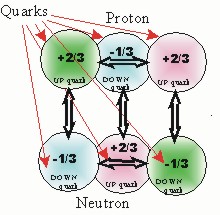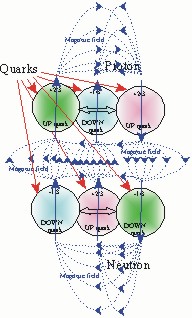
Protons and Neutrons
Why are Protons and Neutron The Shape of Things to Come?
One of the latest developments in nuclear physics is the realization that lattice structures and shell structure both yield similar types of data. These are the types of data that are prescribed to the nucleus.
A lattice structure is controlled by the Shape
of the nucleons.
Thus, it is critical to determine if nucleons are spherical
or have some other shape?

The first break through came when we realized that three particles form a triangle not a sphere. In fact no matter how you arrange three particles they will always form a triangle and all three of the particles will be situated in the same plane.

The second break through came when the obvious grew into a gleaming reality that the electrical charges of the quarks in protons and neutrons would line up for maximum coupling.
Electrical positive charges always attract negative electrical charge and always repel positive electrical charges even at the nuclear level. As a result the quarks in protons and neutrons will generate electrically attractive and electrically repulsive forces between the quarks in protons and neutron. There are electrical attractive and repulsive forces at work in the nucleus as well as the strong force and color confinement.
THUS:

Protons with two positive (+2/3) charged 'up quarks'
and one negative (-1/3) charged 'down quark.'
will matched with the
Neutrons, two negative (-1/3) charged 'down quarks'
and one positive (+2/3) charged 'up quark.'
The two 'up quarks' of the proton align with
the two 'downs quarks' of the neutron,
and
the one 'down quark' in the proton aligns with
the one 'up quark' in the neutron.
This alignment results in a deuteron with the quarks aligned but the deuteron is still composed of a proton and a neutron that are held together primarily by the strong force. However, the structure of the deuteron is controlled by the electric forces of the quarks.

Then it became obvious that if the quarks� electric charges would match up positive to negative to maximize electrical coupling that quarks� magnetic dipoles would also align in an optimum coupled arrangement with north poles adjoined to south pole.
The lattice alignment is first and primarily controlled by the electric charges of the quarks. The magnetic field provides a secondary effect, the primary effect of the magnetic field provides energy as the lattice adjust to accommodate changes in balance resulting from odd number of nucleons. As magnetic fields add vectorially and obey the law of superposition. Thus, lattice deformation of odd number nuclei can be determined by the deviation of total magnetic dipole when it is compared to the magnetic field that would result from complete and optimum magnetic alignment of the individual quark magnetic dipoles.
Thus the deviation of the expected and measured dipole is a measure of imbalance in the nucleus
Ultimately
Stable Nuclear Structure is Primarily about Balance.
The stable nuclei that are lighter than carbon are some of the most interesting to study especially when considering mechanical balance. Interestingly, nuclei heavier than carbon12 provide a continuous study of stability and balance.
The nucleus is balanced radially around the center. This center is the geometric center which coincides with the center of mass and which coincides with the center of electrical charge. This is easy when there is an equal or even number of protons and an equal or even number of neutrons. When either the number of proton or the number of neutrons is an odd number the imbalance is compensated for via the magnetic field. The mechanics of this process will be discussed later in this treatment.
To Recap
The exclusion principle keeps quarks and other nucleons apart.
The Strong force holds the protons and neutrons together.
Color confinement holds the quarks in the protons and neutrons
But, neither the strong force, color confinement nor the exclusion principle provides any torque or alignment force that can impose structure on the nucleus.
However, electric and magnetic forces always align in and along preferential orientations. It is this preferential orientation or alignment resulting from the electric and magnetic fields of the quarks that controls and dictates nuclear structure.
We worried that showing the quark structure of the nucleons, protons and neutrons, rather than just the nucleon structure could lead to a misunderstanding of this model. However it is hard to explain how proton and neutrons interact with each other without showing how the quarks and the electrical charges of the quarks interact. It is the electrical charges of the individual quarks that controls the structure of the nucleus.
The global electrical charge of protons is felt primarily outside the nucleus.
Inside the nucleus the local electrical field from the quarks are dominant until the nucleus contains approximately 48 protons. At that point the building positive electrical macro field starts to have an effect on the lattice structure of the nucleus. This effect creates voids or open gaps in the structure where protons would normally fit.
Quarks not only carry a color charge they also carry an electrical charge. Remember the color charge holds the nucleus together and the strong force holds the protons and neutron inside the nucleus, but it is the electrical charge that controls and builds the lattice structure of the nucleus. Protons and neutron exist as particulates that are composed of three particles, quarks.
Essentially the UP and DOWN quarks are electrical mirror images of each other when just the sign of the electrical charge is considered (+ and -). but UP and DOWN quarks are NOT electrical charge mirror images (+2/3e and -1/3e).